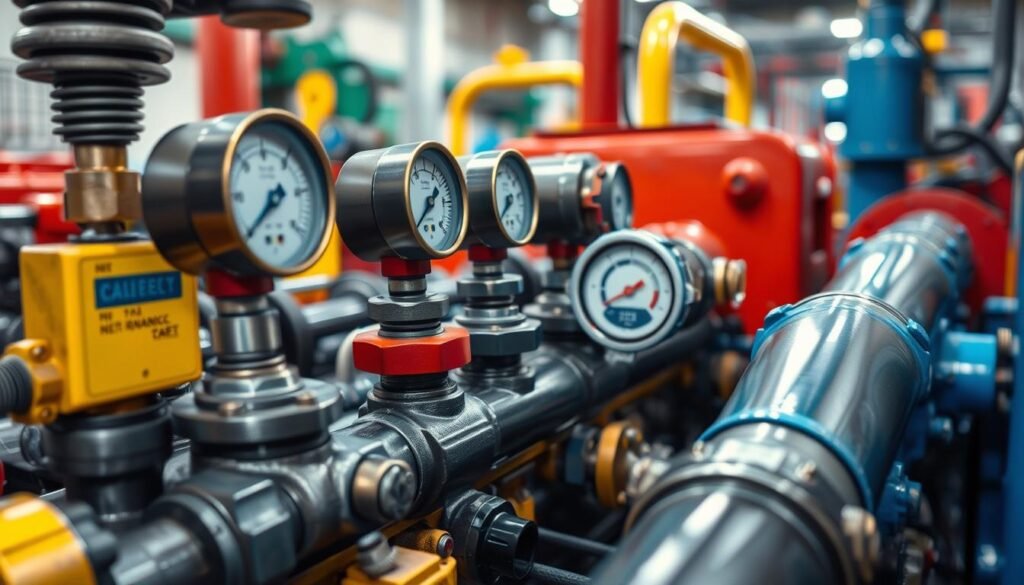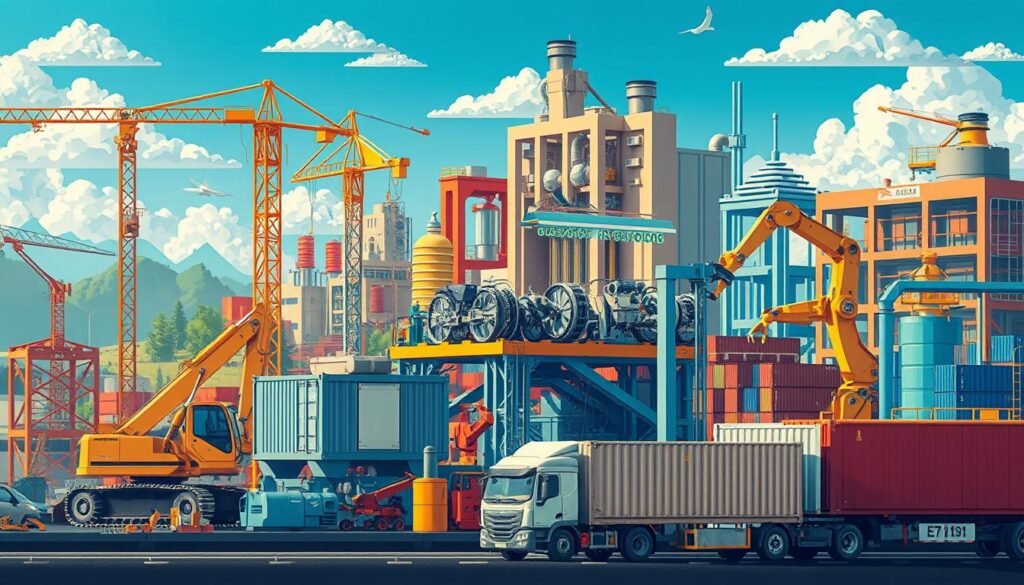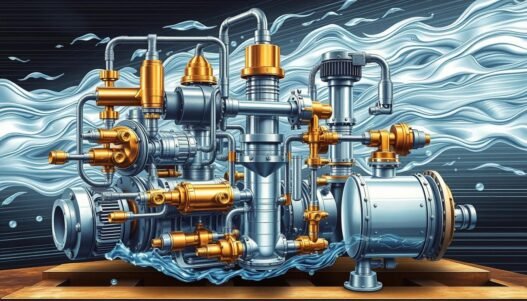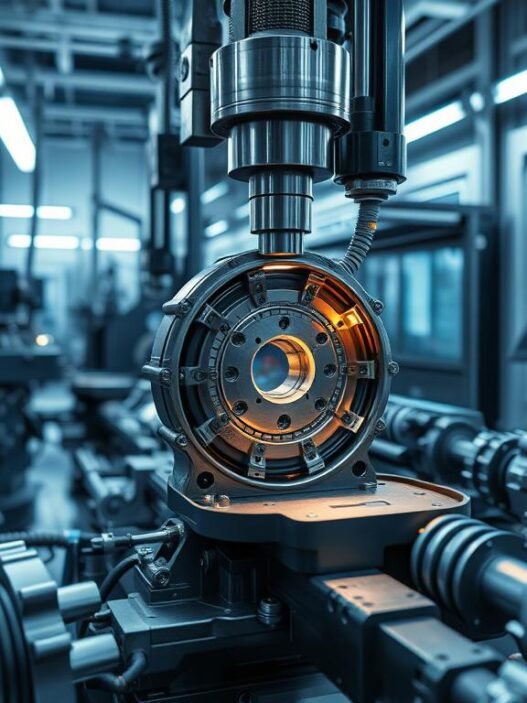Did you know that a hydraulic reservoir should be three times the pump’s output? This shows how important hydraulic systems are in managing power. They use fluid mechanics to move force, key in many industries like manufacturing and agriculture.
This guide will cover the basics of hydraulic systems. We’ll look at their parts, history, benefits, and uses. Knowing how they work boosts efficiency and shows their growth and green practices.
Key Takeaways
- Hydraulic systems are vital for power transmission through fluid mechanics.
- Reservoir volume should be three times the rated output of the pump according to traditional standards1.
- Modern technology has led to a shift from the traditional volume guidelines, suggesting that factors like ambient temperature now play a crucial role1.
- Smaller hydraulic reservoirs offer benefits like compactness and lower costs1.
- Hydraulic systems typically operate at higher pressures (1500 to 2500 psi), leading to enhanced performance2.
- Higher operating costs may make pneumatic systems less efficient compared to hydraulic systems despite their initial cost advantages2.
- Maintenance personnel with advanced skills are essential for the upkeep of hydraulic systems due to their complexity2.
Introduction to Hydraulic Systems
Hydraulic systems are key in today’s machines, using fluid power to move energy well. They work because liquids can’t be compressed. This lets them send force or pressure smoothly from one place to another. This makes them great for jobs that need lots of power and accuracy3.
A hydraulic system has important parts like pumps, hoses, cylinders, valves, and cooling units. It also has reservoirs, filters, and hydraulic fluid, usually oil3. These systems can push with forces from 1500 to 2500 psi, making big forces from small parts3. They’re getting more popular because they make things simpler and work better3.
Many industries like paper mills, logging, and manufacturing use hydraulic systems a lot4. It’s important for people to know how to stay safe around these systems. Not following safety rules can cause big injuries, like getting crushed or losing a limb4.
Defining Hydraulic Systems
Hydraulic systems use incompressible fluids to transmit power. This is key to their definition. They work by Pascal’s Law, where force applied in one place can move to another. This makes them very power efficient compared to other systems.
Historically, hydraulic technology started in London in 1882. It used pressurized water to power factory machines5. By the 1920s, self-contained units were made. These units helped hydraulic systems grow in use across many industries5.
Today, hydraulic systems are crucial in many areas. They’re used in cars, construction, and even in space. For example, they help with brakes and power steering in cars. They’re also in heavy machinery and aircraft, showing their wide range of uses6.
Basics of Hydraulic Mechanisms
The hydraulic mechanism basics start with Pascal’s Law. It says pressure on a fluid spreads out evenly in all directions. This law helps make hydraulic systems powerful, used in many places like brakes and big machines7.
For example, pushing down with 5 pounds on a 1-inch square area makes 5 psi pressure. This pressure then pushes back with 50 pounds8. Hydraulic systems use this to control forces precisely and smoothly.
Hydraulic systems come in different setups. A simple one has a reservoir, pump, relief valve, and more8. Double-acting cylinders can push and pull, using a special valve for control.
Hydraulic systems work because of fluid mechanics. Fluid movement controls how the system works. For instance, moving 1 gallon per minute can make a piston move 20 inches per minute8. This shows how hydraulic systems are efficient and reliable, important in many fields.
To sum up, knowing about hydraulic mechanisms is key. It helps us understand their role in today’s industries7. For more on keeping hydraulic systems running well, check out this resource.
Components of a Typical Hydraulic System
A typical hydraulic system has key parts that work together. They help move fluid efficiently and control it well. Each part is important for the system to work well, last long, and function right.
Reservoir Functionality
The reservoir is a key part of any hydraulic system. It holds hydraulic fluid and gives the pump fluid to work with. It also has extra fluid to make up for losses over time, keeping the system running smoothly9.
The design of the reservoir is also important. Good designs help keep air and dirt out. This is crucial for the system to last longer.
Pump Operation
The hydraulic pump changes mechanical energy into hydraulic energy. It moves fluid from the reservoir into the system. There are different pumps, like gear pumps and piston pumps, each with its own strengths9.
This change of energy is key for hydraulic systems to work in many ways.
The Role of Valves
Valves are crucial for controlling fluid flow, pressure, and direction. Directional control valves are very important. They let operators control where fluid goes, making sure it goes where it’s needed10.
These valves help direct hydraulic power to its right use. This could be lifting heavy things or controlling machinery movements precisely.
Understanding Hydraulic Reservoirs
Hydraulic reservoirs are key to how well hydraulic systems work. They affect both how well the system performs and how efficient it is. It’s important to size these reservoirs right, as it impacts how well they manage heat and keep fluid quality up.
They need to be big enough to hold the hydraulic fluid used and help get rid of heat efficiently.
Importance of Reservoir Volume
Having the right reservoir volume is vital. It ensures the system has enough room to work well and manage heat. Experts say reservoirs should be about three times the pump’s rated output in volume. This helps the system work well in many situations, like powering big machines11.
Bigger tanks help get rid of heat better. This is important because small tanks can’t handle the heat well, especially in systems with big cylinders or rods. These can make it hard for fluid to return when the system is extending12.
Pros and Cons of Smaller Reservoirs
Smaller reservoirs have their good points and bad points. They can save money and reduce the chance of fluid leaks. But, there are downsides to consider, like not settling contaminants well and more chance of pump cavitation. It’s important to balance these to keep the system running smoothly12.
Safety and Maintenance of Hydraulic Systems
Hydraulic system safety is key, especially since these systems hold fluid under high pressure. This pressure is often over 2,000 pounds per square inch13. Risks include burns from hot fluid, injuries from moving lines, and severe injection injuries13. Even 100 psi can pierce skin, showing the need for strict safety rules14.
Regular maintenance is vital to avoid accidents and keep systems working well. OSHA stresses the importance of lockout and tagout procedures for safety15. Checking hoses and disposing of spilled oil safely can lower accident risks14.
Wearing safety gear like glasses, closed-toe shoes, and face shields is a must when working with hydraulics14.
For better safety, it’s good to check for oil leaks, replace old hoses, and keep connections tight13. Leaks can cause low pressure and fluid loss14. Never check for leaks with your hands; use gloves or cardboard instead14. Also, make sure hoses are tied down to prevent them from whipping if they break14.
When maintaining, it’s important to depressurize systems safely to avoid burst fluids15. Using old parts like hoses and fittings can increase failure risks15. So, following the original equipment manufacturer’s (OEM) maintenance guidelines is essential for safety and reliability15.

Historical Overview of Hydraulic Applications
The history of hydraulic systems starts with the ancient Greeks and Egyptians around 600 BC. They used irrigation and water clocks16. The Shushtar Historical Hydraulic System, built by Persians in the third century CE, shows early technology. It had water supply, irrigation, and river transportation17.
The Romans made big strides in hydraulic engineering. They built aqueducts that could last one to three weeks, showing their skill17. They also used ‘hushing’ in hydraulic mining, which helped during the California Gold Rush17.
The Industrial Revolution was a big leap for hydraulic systems. Joseph Bramah made the first hydraulic press in 1795, which was key for later progress16. The choice of oil over water for hydraulic fluids was made because of its non-corrosive nature and ability to work well at high pressures and temperatures16.
Blaise Pascal discovered Pascal’s Law in 1648, and Daniel Bernoulli published Hydrodynamica in 1738. Their work is the foundation of modern hydraulic technology17.
In the 19th century, scientists like Isaac Newton and Jean Léonard Marie Poiseuille deepened our understanding of fluid dynamics. This connection between fluid mechanics applications and practical use in hydraulic systems grew stronger17. William George Armstrong’s work and hydraulic crane designs showed the power of hydraulic systems17.
Today, hydraulic systems are crucial in many fields like heavy machinery, mining, marine, and automotive. This shows how far they’ve come and how important they are16.
Industries Relying on Hydraulic Systems
Hydraulic systems are key in many sectors, making work more efficient. In construction, they help finish big projects quickly, needing fewer people. Excavators use hydraulics to dig and move materials precisely1819.
In farming, hydraulics power modern machines, letting a few people do what many used to do. Landscapers use hydraulic tools like dump trucks and tree chippers for quick outdoor space upkeep1820.
The car industry relies on hydraulic systems for brakes and transmissions19. Aerospace uses hydraulics for landing gear in planes and rockets, ensuring safety20.
Entertainment boosts visitor fun with hydraulic rides, like ferris wheels and water attractions18. In shipping, hydraulic gear helps load and unload, showing its role in logistics18.
The energy sector uses hydraulics in water plants for better flow and efficiency20. Mining, oil, and gas use hydraulic machines for digging and processing, cutting down on manual work19.
Many industries benefit from hydraulic systems. They are reliable and make work more effective, leading to success.

Environmental and Economic Benefits of Hydraulic Systems
Hydraulic systems are key in solving environmental problems and boosting the economy. They help manage resources better and use new tech to cut down on harm to the environment. Using energy-saving hydraulic pumps can save a lot of money and use less power. Many pumps today are over 90% efficient21.
Switching to eco-friendly hydraulic fluids is also important. These fluids help reduce pollution because many oil products break down quickly22. Choosing the right lubricants can make pumps up to 6% more efficient. This helps companies save money and be more green22.
Designing and keeping hydraulic systems efficient is also crucial. Smart controls and training can make them even better. This helps save energy and money, and is good for the planet21. Hydraulic engineering tackles big issues like climate change and water shortages. It’s vital for future projects in civil engineering23.
Hydraulic tech keeps getting better, leading to greener solutions. This change helps protect the environment and supports economic growth. It shows a strong commitment to being eco-friendly and competitive23.
| Aspect | Environmental Impact | Economic Benefit |
|---|---|---|
| Energy Efficiency | Reduces power consumption, contributing to lower carbon footprint | Significant cost savings on energy bills |
| Fluid Selection | Utilization of biodegradable fluids reduces pollution | Improved longevity and reduced maintenance costs |
| System Design | Minimizes waste and environmental degradation | Enhances overall operational effectiveness and reliability |
Conclusion
Hydraulic systems are key in many fields, making things work better and more efficiently. They are used in gas pumps, cars, and building machines. For example, they help cars stop better and make dishwashers quieter2425.
The future of hydraulics looks bright with a focus on being green and new. New tech in building machines and electronic controls will make hydraulics even better26. Also, making things more eco-friendly will be important for keeping our planet safe.
Hydraulic systems are a big deal in today’s world, working behind the scenes but making a big impact. As they get better, they will help the economy and protect our environment2425.
















